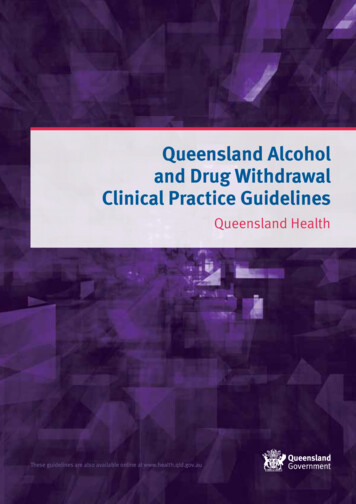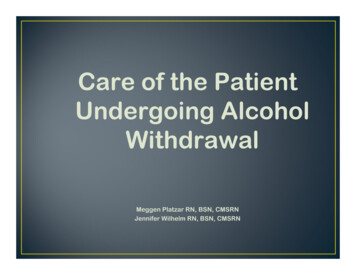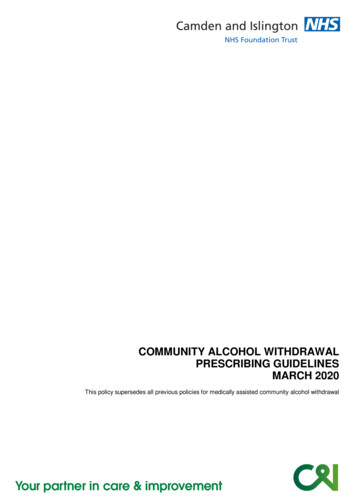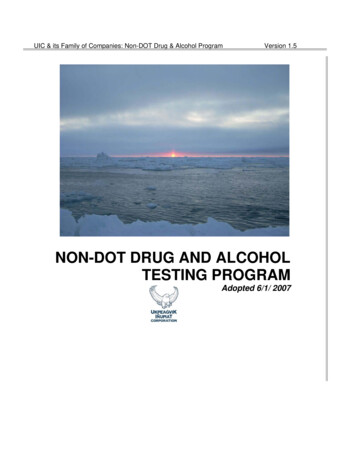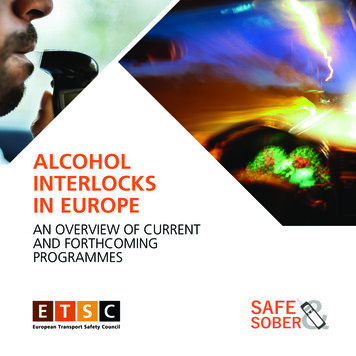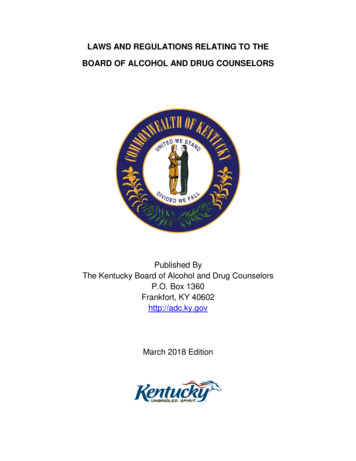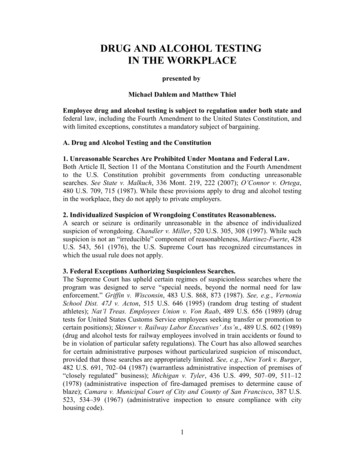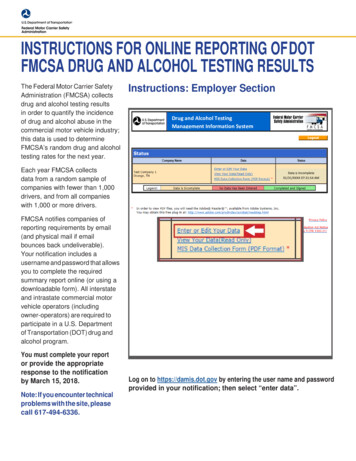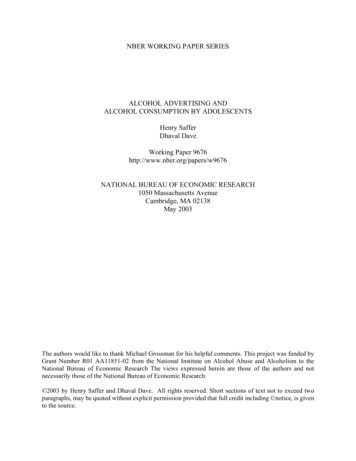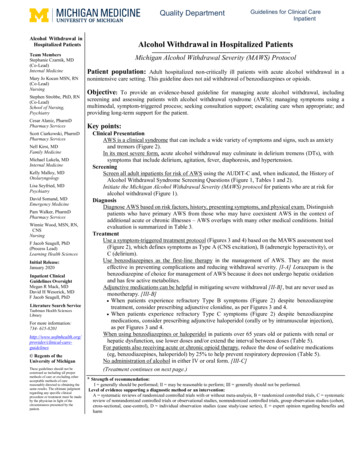
Transcription
Quality DepartmentAlcohol Withdrawal inHospitalized PatientsTeam MembersStephanie Czarnik, MD(Co-Lead)Internal MedicineMary Jo Kocan MSN, RN(Co-Lead)NursingGuidelines for Clinical CareInpatientAlcohol Withdrawal in Hospitalized PatientsMichigan Alcohol Withdrawal Severity (MAWS) ProtocolPatient population: Adult hospitalized non-critically ill patients with acute alcohol withdrawal in anonintensive care setting. This guideline does not aid withdrawal of benzodiazepines or opioids.Objective: To provide an evidence-based guideline for managing acute alcohol withdrawal, includingStephen Strobbe, PhD, RN(Co-Lead)School of Nursing,Psychiatryscreening and assessing patients with alcohol withdrawal syndrome (AWS); managing symptoms using amultimodal, symptom-triggered process; seeking consultation support; escalating care when appropriate; andproviding long-term support for the patient.Cesar Alaniz, PharmDPharmacy ServicesKey points:Scott Ciarkowski, PharmDPharmacy ServicesNell Kirst, MDFamily MedicineMichael Lukela, MDInternal MedicineKelly Malloy, MDOtolaryngologyLisa Seyfried, MDPsychiatryDavid Somand, MDEmergency MedicinePam Walker, PharmDPharmacy ServicesWinnie Wood, MSN, RN,CNSNursingF Jacob Seagull, PhD(Process Lead)Learning Health SciencesInitial Release:January 2020Inpatient ClinicalGuidelines OversightMegan R Mack, MDDavid H Wesorick, MDF Jacob Seagull, PhDLiterature Search ServiceTaubman Health SciencesLibraryFor more information:734- l-careguidelines Regents of theUniversity of MichiganThese guidelines should not beconstrued as including all propermethods of care or excluding otheracceptable methods of carereasonably directed to obtaining thesame results. The ultimate judgmentregarding any specific clinicalprocedure or treatment must be madeby the physician in light of thecircumstances presented by thepatient.Clinical PresentationAWS is a clinical syndrome that can include a wide variety of symptoms and signs, such as anxietyand tremors (Figure 2).In its most severe form, acute alcohol withdrawal may culminate in delirium tremens (DTs), withsymptoms that include delirium, agitation, fever, diaphoresis, and hypertension.ScreeningScreen all adult inpatients for risk of AWS using the AUDIT-C and, when indicated, the History ofAlcohol Withdrawal Syndrome Screening Questions (Figure 1, Tables 1 and 2).Initiate the Michigan Alcohol Withdrawal Severity (MAWS) protocol for patients who are at risk foralcohol withdrawal (Figure 1).DiagnosisDiagnose AWS based on risk factors, history, presenting symptoms, and physical exam. Distinguishpatients who have primary AWS from those who may have coexistent AWS in the context ofadditional acute or chronic illnesses – AWS overlaps with many other medical conditions. Initialevaluation is summarized in Table 3.TreatmentUse a symptom-triggered treatment protocol (Figures 3 and 4) based on the MAWS assessment tool(Figure 2), which defines symptoms as Type A (CNS excitation), B (adrenergic hyperactivity), orC (delirium).Use benzodiazepines as the first-line therapy in the management of AWS. They are the mosteffective in preventing complications and reducing withdrawal severity. [I-A] Lorazepam is thebenzodiazepine of choice for management of AWS because it does not undergo hepatic oxidationand has few active metabolites.Adjunctive medications can be helpful in mitigating severe withdrawal [II-B], but are never used asmonotherapy. [III-B] When patients experience refractory Type B symptoms (Figure 2) despite benzodiazepinetreatment, consider prescribing adjunctive clonidine, as per Figures 3 and 4. When patients experience refractory Type C symptoms (Figure 2) despite benzodiazepinemedications, consider prescribing adjunctive haloperidol (orally or by intramuscular injection),as per Figures 3 and 4.When using benzodiazepines or haloperidol in patients over 65 years old or patients with renal orhepatic dysfunction, use lower doses and/or extend the interval between doses (Table 5).For patients also receiving acute or chronic opioid therapy, reduce the dose of sedative medications(eg, benzodiazepines, haloperidol) by 25% to help prevent respiratory depression (Table 5).No administration of alcohol in either IV or oral form. [III-C](Treatment continues on next page.)* Strength of recommendation:I generally should be performed; II may be reasonable to perform; III generally should not be performed.Level of evidence supporting a diagnostic method or an intervention:A systematic reviews of randomized controlled trials with or without meta-analysis, B randomized controlled trials, C systematicreview of nonrandomized controlled trials or observational studies, nonrandomized controlled trials, group observation studies (cohort,cross-sectional, case-control), D individual observation studies (case study/case series), E expert opinion regarding benefits andharm
(Treatment continued.)When starting treatment for alcohol withdrawal, also give thiamine 100 mg PO/IV daily, folic acid 1 mg PO/IV daily, anda multivitamin PO daily. Continue giving these vitamins for 7-14 days. [I-C]Consider consultation for difficult or complicated AWS. Examples of relevant clinical expertise for various conditionsinclude: Critical care consultation may be appropriate for patients with hemodynamic or respiratory instability, progression ofsymptoms despite maximum appropriate therapy, or high-intensity nursing requirements. [I-E] Consider maternal-fetal medicine consultation for pregnant patients, general medicine for significant comorbidconditions, and psychiatry for concomitant psychiatric issues and medications. [II-E]Transfer to a higher level of care is a multidisciplinary decision of the responsible physician, consult team, and nursingstaff.Hospital DischargeDefer discharge until symptoms attributed to alcohol withdrawal have resolved.Do NOT provide patients with “as needed” (prn) medications to manage symptoms following discharge. [III-E] Whenpatients who were treated with symptom-triggered therapy are ready for discharge, they are no longer at significant riskfor continued or rebound withdrawal.Provide patients with written information and guidance to support continued abstinence from alcohol. [I-C] At UMHS, thisis done by the General or Psychiatric Social Work Department.Hospital Follow-UpSchedule a follow-up appointment with the patient’s Primary Care Physician within 2 weeks of hospital discharge. [I-E]2 Alcohol Withdrawal in Hospitalized Patients Guideline January 2020
Figure 1. Universal Screening for Risk of Alcohol Withdrawal Syndrome and Initiation of the Michigan AlcoholWithdrawal Severity (MAWS) Protocol*SBIRT Screening, brief intervention, and referral to treatment*SBIRT Screening, brief intervention, and referral to treatment3 Alcohol Withdrawal in Hospitalized Patients Guideline January 2020
Table 1. AUDIT-C QuestionnairePresent all questions to the patient verbatim. Preferred methods are self-administered questionnaire or clinician inquiry. Optionswhen the patient is unable to respond include medical record review or asking a family member.A standard drink is defined asfollows: 12 oz. beer, 5 oz. glass ofwine, or 1.5 oz. of 80-proof distilledspirits, according to the NationalInstitute on Alcohol Abuse andAlcoholism (NIAAA).Scoring (points)PointsQuestions01234How often do you have a drinkcontaining alcohol?Never1 time amonth orless2 to 42 to 3times aweek4 or moretimes aweektimesa monthIf answer is Never (0 points), stop screening here How many drinks containing alcohol doyou have on a typical day when you aredrinking?How often do you have five or moredrinks on one occasion?1 to 23 to 45 to 67 to 910 or moredrinksdrinksdrinksdrinksdrinksNeverLess thanmonthlyMonthlyWeeklyDaily oralmostdailyTotal Score (Add points for all three questions) Scores of 8 are considered positive for withdrawal in both men and womenfor initial AWS screening in the context of this clinical guideline.1Note: The AUDIT-C is an evidence-based, three item scale used to identify patients who engage in risky or hazardousdrinking. Among those diagnosed as having hazardous or harmful alcohol use, 92% had an AUDIT score of 8 ormore, and 94% of those with non-hazardous consumption had a score of less than 8. Training information on theadministration of the AUDIT questions can be found here: https://www.youtube.com/watch?v RHcalohcunU4 Alcohol Withdrawal in Hospitalized Patients Guideline January 2020
Table 2. History of Alcohol Withdrawal Syndrome Screening QuestionsPresent all questions to the patient verbatim. Preferred methods are self-administered questionnaire or clinician inquiry. Optionswhen the patient is unable to respond include medical record review or asking a family member.Questions (Answering YES to any indicates a positive history)Have you ever had seizures when you stopped drinking?Have you ever had delirium tremens (DTs) when you stopped drinking? *Have you ever had other withdrawal symptoms when you stopped drinking? *** DT signs/symptoms include visual, auditory or tactile hallucinations, agitation, tachycardia,hypertension, fever, or diaphoresis along with delirium. Symptoms and signs arise 48-96 hoursafter alcohol cessation.**Other signs/symptoms include insomnia, tremulousness, mild anxiety, gastrointestinal upset oranorexia, headache, diaphoresis and palpitations along with abnormal mental status which can arisewithin six hours of alcohol cessation.Table 3. Baseline Diagnostic Evaluation of Patients at High Riskfor Acute Alcohol Withdrawal SyndromeComplete history and physical examBlood alcohol level (BAL)Urine toxicology screenComplete blood count and differential, basic metabolicprofile with magnesium and phosphorus levels, liverfunction testsElectrocardiogram (ECG)5 Alcohol Withdrawal in Hospitalized Patients Guideline January 2020
Figure 2. Michigan Alcohol Withdrawal Severity (MAWS) ScaleAt UMHS, this form is available through the electronic medical recordTYPE A SYMPTOMS (CNS Excitation) Assess these symptoms by observation. Do not use patient self-report.a. Does patient appear anxious or nervous?(eg, appears hyper-vigilant, apprehensive, tense, panicky)b. Does patient appear restless?(eg, picking at objects, constantly moving, fidgety, pacing)c. Is patient bothered by bright light?(eg, keeps eyes closed, squinting at bright lights)d. Is patient bothered by loud sounds?(eg, complains about loud voices, winces to loud noise)Assign one point for each symptom groupMaximum points: 4If MAWS score 1, administer lorazepam as ordered every 1hour as needed until MAWS score 0 OR patient is calm andcooperative.Continue to assess patient every 1-2 hours per protocolTYPE B SYMPTOMS (Adrenergic Hyperactivity) These symptoms should not have an alternative explanationa.b.c.d.e.Nausea or vomitingTremor visible with or without arms extendedSweat visible on palms or foreheadBlood pressure, either: SBP either 30mm Hg over baseline or 170mm Hg DBP 20mm Hg over baseline or 100mm HgHeart rate 110Assign one point for each symptomMaximum points: 5If MAWS score is 2 with presence of 2 or more Type Bsymptoms not responsive to lorazepam, contact clinician toconsider adjunctive clonidine. If patient is hypertensive and has a history ofhypertension, administer routine antihypertensives priorto clonidine If clinician orders, administer clonidine as ordered every 2hours as needed x 3 doses until type B score 2 Hold clonidine if systolic BP decreases by 30 mm HgOR diastolic BP decreases by 20 mm Hg with any doseIf MAWS 1, continue lorazepam, unless otherwise specifiedby clinician.TYPE C SYMPTOMS (Delirium) Assess if there has been an acute change from baseline*a.Is the patient unable to be re-directed in any of thefollowing: Inappropriate behavior Disinhibition Disorientation- cannot state name, date, or place Hallucinations - auditory, tactile, and/or visualAssign one-point total if any symptoms are presentMaximum points: 1If MAWS score 1 with Type C symptoms not responsive tolorazepam, contact clinician to consider adjunctive haloperidol. If clinician orders, administer haloperidol as ordered every2 hours as needed until either:- Type C symptoms resolve- Patient is calm and cooperative- Patient can be redirected. Avoid administering lorazepam within 1 hour ofhaloperidol*Assess for history of dementia to identify any baselinepatient behavioral characteristics that may bemisclassified as Type C symptomsList baseline characteristics here:1.2.3.If MAWS 1, continue lorazepam, unless otherwise specifiedby clinician.Sum of Type A, B, and C scoresMaximum 10 pointsTotalAdapted from: DePetrillo P, McDonough M. Alcohol withdrawal treatment manual. Glen Echo, MD: Focused Treatment Systems, 1999.6 Alcohol Withdrawal in Hospitalized Patients Guideline January 2020
Figure 3. Michigan Alcohol Withdrawal Severity (MAWS) Protocol for Mild to Moderate Alcohol Withdrawal7 Alcohol Withdrawal in Hospitalized Patients Guideline January 2020
Figure 4. Michigan Alcohol Withdrawal Severity (MAWS) Protocol for Severe Withdrawal8 Alcohol Withdrawal in Hospitalized Patients Guideline January 2020
Table 4. Medication Characteristicsof Half-lifeDrugOnsetActionLorazepam2-3 min IV12-14 hours30 min POESRD 18 ions/Potential Side EffectsHepaticUrinary, fecalRespiratory depressionOversedationAcidosis – high dose IVPregnancy risk factor: DClonidineHaloperidol10 min IV12-16 hours30-60 min POESRD 41 hoursBradycardiaRenalnecessaryPregnancy risk factor: C30-60 min IM30-60 min PO10-37 hoursHepaticUrinarydosingHepaticUrinary, fecalHypotensionQT prolongationOversedationDystoniaReduced seizure thresholdPregnancy risk factor: C9 Alcohol Withdrawal in Hospitalized Patients Guideline January 2020
Table 5. Recommendations for Medication Administration and WithholdingMedicationPatient AssessmentAdministration and WithholdingDose AdjustmentsLorazepamAssess patient sedation score (eg,UMSS* or RASS*), respiratoryrate (RR), and oxygen saturationbefore and one hour after eachdose.Withhold medication if sedation of moderatelevel or greater (eg, UMSS score 2, orRASS score 3); RR 10; oxygen saturation 90% (unless there is an alternativeexplanation for hypoxia).Lower doses and/or extenddosing intervals in patientsover 65 years old, or those withrenal or hepatic dysfunction.Avoid coadministration (within one hour) withhaloperidol or opioids unless directed byprovider due to potential for oversedation.Use with caution during first trimester ofpregnancy.Reduce dose by 25% if patient ischronicallyoracutelyreceiving opioids due topotentialforrespiratorydepression.Administer orally if possible. Use parenteralroutes (IM, IV) when patient cannot tolerateoral administration.ClonidineReassess blood pressure and heartrate one hour after each dose.Hold dose if systolic BP 130; diastolic BP 70 mm Hg; heart rate 60 beats per minute.Discontinue clonidine if any dose results inSBP decrease 30 mm Hg, or DBP decreaseof 20 mm Hg.Reduce dose in renal impairment.Use with caution during first trimester ofpregnancy.Administer orally if possible. Use parenteralroutes (IM, IV) when patient cannot tolerateoral administration.HaloperidolAssess patient sedation score (eg,RASS* or UMSS*), respiratoryrate, and oxygen saturationbefore and one hour after eachdose.Withhold medication if sedation of moderatelevel or greater (eg, UMSS score 2, or RASSscore 3); RR 10; oxygen saturation 90%(unless there is an alternative explanation fordesaturation).Obtain baseline ECG to assess QTinterval; repeat ECG to monitorQTc interval if use exceeds 48hours.Avoid coadministration (within one hour) withlorazepam or opioids unless directed byprovider due to potential for oversedation.Avoid further use of haloperidol if QTc interval 450 ms.Lower doses and/or extenddosing intervals in patientsover 65 years old, or those withrenal or hepatic dysfunction.Reduce dose by 25% if patient ischronicallyoracutelyreceiving opioids due topotentialforrespiratorydepression.Avoid in patients with Parkinson’s disease orAfrican American race due to increased riskof tardive dyskinesia.Avoid in persons with epilepsy or seizuresbecause it can decrease the seizure threshold.Do not use during first trimester of pregnancy.Administer orally if possible. Use parenteralroutes (IM) when patient cannot tolerate oraladministration.10 Alcohol Withdrawal in Hospitalized Patients Guideline January 2020
* UM Sedation Scale (UMSS) (Internal link for University of Michigan only) and Richmond Agitation-Sedation Scale (RASS)Table 6. Recommended Daily Nutritional SupplementationNutritional SupplementDoseMultivitamin1 tablet PO dailyThiamine100 mg PO/IV daily x 7 - 14 daysFolic Acid1 mg PO/IV daily x 7 - 14 days11 Alcohol Withdrawal in Hospitalized Patients Guideline January 2020
Clinical Problem and Management IssuesIntroductionAlcohol withdrawal syndrome (AWS) is a constellation ofsymptoms that occurs when a patient with sustained alcoholuse experiences a sudden decrease in alcohol consumption.This guideline describes AWS and offers recommendationsfor identification, evaluation, and management of AWS inthe hospital setting.The Diagnostic and Statistical Manual for Mental HealthDisorders, 5th Edition (DSM-5), released in May 2013,combined the previously separate diagnoses of “alcoholabuse” and “alcohol dependence” and replaced them withsingle diagnosis of “alcohol use disorder.”2IncidenceAlcohol consumption in the United States contributes toapproximately 85,000 deaths annually. Alcohol dependenceor hazardous drinking behaviors have become increasinglycommon, occurring in up to 15-20% of patients in theambulatory setting. Recent data describe hazardous alcoholuse or high-risk behaviors in 22.3% of adults over a onemonth period. Although males have a higher incidence ofalcohol use disorder, in one survey up to 51.5% of womenused alcohol during pregnancy, 15% of whom engaged inbinge drinking.Patients entering the acute-care hospital setting have asimilar prevalence of alcohol dependence or high-riskbehaviors ranging from 15-25%.3 Of these patients,approximately 10% will demonstrate signs or symptoms ofalcohol withdrawal during their admission. The severity ofwithdrawal is variable and influenced by several factors,which include age, gender, consumption patterns, frequencyof prior withdrawal, and medical comorbidities. Thepresentation of AWS ranges from minor restlessness oranxiety to severe withdrawal and the phenomenon known asdelirium tremens (DTs).The historical mortality among patients experiencing themost severe withdrawal is approximately 15%. As the abilityto recognize and manage AWS has improved, the associatedmortality has decreased to less than 1%. However, AWSremains a considerable challenge for patients and clinicians.Rationale for RecommendationsAWS is frequently observed in emergency departments aswell as inpatient medical and surgical services. Given thespectrum of patient presentation and the breadth of treatmentoptions, management of patients experiencing AWS isinherently complex. These guidelines have been developedto ensure consistent care delivery for patients with AWSacross inpatient services. These guidelines are applicable toall inpatient services and patients, except for patientstransferred to the Intensive Care Units (ICUs) foruncontrolled MAWS, which are beyond the scope of thisguideline.Pathophysiology of AWSThe physiologic perturbations of alcohol withdrawal aremade up of a complex interplay of both excitatory andinhibitory neurochemical pathways. Classically known as aCNS depressant, alcohol causes direct enhancement, andconsequently down-regulation,of theinhibitoryneurotransmitter, gamma-aminobutyric acid (GABA).GABA’s excitatory counterpart, glutamate, is in constantflux as it tries to maintain balance, ultimately resulting in upregulation. This phenomenon, known clinically as tolerance,leads to the need for escalating doses of alcohol to achievethe same effect. Upon withdrawal of alcohol, the CNSinhibition suddenly decreases, causing significant excitation.The resulting autonomic hyperactivity leads to the classicsigns and symptoms of alcohol withdrawal, as outlined inFigure 2.4Another important alcohol-related physiologic phenomenonis called kindling. Kindling is a progressive increase in theintensity of symptoms with each subsequent withdrawalperiod. Repeated episodes of alcohol withdrawal causealterations in GABA, glutamate, and norepinephrinetransmission that increase the risk of seizures and DTs.5Clinical PresentationAWS is a clinical syndrome that can include a wide varietyof symptoms and signs (Figure 2). They can be classified inthree broad categories: CNS excitation (Type A), adrenergichyperactivity (Type B), and delirium (Type C).6Type A symptoms are the result of the CNS excitationdescribed above. They occur within 6-12 hours after the lastconsumption of alcohol. Pharmacological treatments forthese symptoms have traditionally been benzodiazepines.Adrenergic hyperactivity, otherwise known as Type Bsymptoms, may occur between 6-48 hours after alcoholcessation and are associated with elevated norepinephrineand epinephrine levels. The catecholamine surge imposed onthe sympathetic nervous system can cause extremes of bloodpressure, and significant tachycardia. Clonidine (and otheralpha-2 agonists) has been shown to reduce the burden ofnorepinephrine release, while beta blockers such as12 Alcohol Withdrawal in Hospitalized Patients Guideline January 2020
propranolol have also been shown to decrease autonomicsymptoms.7,8Type C symptoms include delirium and hallucinations. Incontrast to Type A and B symptoms, Type C symptoms canbe seen up to 2 weeks after alcohol cessation. The associateddelirium and hallucinatory effects may be experiencedbetween 2 to 10 days after alcohol cessation, despite attemptsat control with pharmacological management such ashaloperidol.6Delirium tremens (DTs) is a clinical diagnosis based on aconstellation of symptoms that include delirium, agitation,fever, diaphoresis, and hypertension.Alcohol withdrawal can also inherently cause seizures. DTsare not synonymous with alcohol-related seizure activity.Withdrawal seizures and alcoholic hallucinations areseparate entities that can manifest during the first 48 hours ofAWS and are self-limited. They may occur alone, or as partof DTs.The time course of AWS symptom development is welldescribed. Central nervous system excitation (eg, anxiety,nervousness) and adrenergic hyperactivity (eg, tremor,diaphoresis, hypertension) typically develop in the first 6 to36 hours after alcohol cessation, while delirium tremens(DTs) typically develop after 48 to 96 hours. However,patients with significant alcohol abuse may manifest signs orsymptoms of withdrawal even in the presence of detectableserum alcohol levels.ScreeningRecommendations:Screen all adult inpatients for risk of AWS, using theAUDIT-C and, if indicated, History of AlcoholWithdrawal Syndrome screening questions (Figure 1,Tables 1 and 2). Initiate the Michigan Alcohol Withdrawal Severity(MAWS) protocol for patients who are at risk foralcohol withdrawal (Figure 1). The purpose of universal screening for risk of AWS amongall adult inpatients is to identify those who are more likely todevelop AWS and to promote early identification,intervention, treatment, and referral. About 20% of all adultmedical inpatients are engaging in risky or hazardous alcoholuse prior to hospital admission, and approximately 77% ofthese patients are alcohol dependent.9 With the abruptcessation of alcohol consumption that usually accompaniesinpatient hospitalization, a significant subset of thatpopulation is at risk for the development of AWS.10 Theneurophysiological model of kindling suggests thatsubsequent episodes of alcohol withdrawal becomeincreasingly severe with decreased provocation.11 Untreatedor undertreated AWS during hospitalization has beenassociated with an increased incidence and severity of acutemedical complications, increased lengths of stay, morefrequent transfers to ICUs, increased hospital-related costs,and higher rates of patient mortality.12Once symptoms appear, progression to severe AWS can beprevented if symptoms are identified, monitored, and treatedaggressively.13 Despite the pronounced prevalence andserious consequences of AWS, no universally acceptedscreening instrument for symptoms yet exists. The revisedClinical Institute Withdrawal Assessment of Alcohol Scale(CIWA) is the most commonly used scoring system forrecognition of AWS symptoms. However, in our experience,CIWA is too complex and subjective to be clinically useful.Instead we recommend a modified version of the AlcoholWithdrawal Risk Assessment (Figure 1) as developed anddescribed by Williams and Mitchell.14 These investigatorsreduced the incidence of alcohol withdrawal and ICUtransfers in AWS patients by using a combined set ofscreening tools. They used a subset of screening questionsfrom the AUDIT-Consumption [AUDIT-C] and AUDITDependence [AUDIT-D] tools (Table 1), in combinationwith questions related to any history of AWS-relatedseizures, delirium tremens (DTs), or other symptoms ofalcohol withdrawal (Table 2).14 In subsequent personalcommunications (2016), Williams reported that AUDIT-Dquestions did not add substantively to the predictive capacityof their model, and they were subsequently deleted.The AUDIT-C is retained in its entirety because it has anestablished role in screening, brief intervention, and referralto treatment (SBIRT) for alcohol use, a public healthapproach to reducing alcohol use and related disorders.15Patients who are identified as high-risk by the abovescreening approach should be started on the treatmentprotocol prophylactically (Figure 1). This allows closemonitoring of these patients and initiation of earlypharmacologic treatment, if indicated.DiagnosisRecommendations: Diagnose AWS based on risk factors, history,presenting symptoms, and physical exam (see ClinicalPresentation above). Distinguish patients who have primary AWS fromthose who may have coexistent AWS in the context ofadditional acute or chronic illnesses. AWS overlapswith many other medical conditions. The initial evaluation of a patient with AWS issummarized in Table 3.AWS is a clinical diagnosis, based on risk factors, history,presenting symptoms, and physical exam. Given its overlapwith other conditions, it is important to understand a patient’s13 Alcohol Withdrawal in Hospitalized Patients Guideline January 2020
baseline medical history so that certain disease exacerbationsare not perceived as being part of a developing AWS (eg, anessential tremor).No specific testing available confirms a diagnosis of AWS.The clinician may try to draw conclusions about the patient’salcohol consumption based on laboratory testing, but thesetests are often nonspecific. In patients who are seekingtreatment for alcohol misuse, biomarkers do not offer anyadvantage over self-report measures. For example, transferase (AST) to alanine aminotransferase (ALT)ratio of 2:1 or higher is not more accurate than self-reportedalcohol consumption, and is less sensitive and specific thanthe AUDIT in screening for alcohol misuse.16-18 Severalstudies have evaluated other laboratory tests such as gammaglutamyl transpeptidase (GGTP), mean corpuscular volume(MCV), or urinary ethyl glucuronide (ETG), but none hasproven reliable or consistent. Biomarkers are of potential usein the outpatient setting because they can provide baselinemeasures of alcohol-related damage and can serve as amotivational strategy to patients.Diagnosis should begin with a detailed history that exploresrisk factors and high-risk behaviors associated with alcoholdependence and subsequent risk of AWS. This includes thetime of last alcoholic drink, amount of alcohol consumed,other illicit or controlled substances used, and family historyof an alcohol use disorder. Universal standardized screeningfor risk of alcohol withdrawal syndrome complements theinformation obtained by history. A detailed physical exammay detect CNS hyperactivity or hyperadrenergic states.Remember that these findings are not specific to AWS, andexclusion or identification of coexistent conditions isimperative.Perform baseline laboratory testing in those suspected ofexperiencing alcohol withdrawal (Table 3). These includethe initial blood alcohol level (BAL), urine toxicologyscreen, complete blood count, basic metabolic profile withmagnesium and phosphorus, and liver function tests. Evenwith a positive BAL, a person can experience significantwithdrawal symptoms. Patients with alcohol dependenceoften have concomitant polysubstance use, and a urinetoxicology screen may identify other substances that maymimic or coexist with AWS. Basic hematologicalmeasurements may identify alcohol induced suppression ofbone marrow, signs of nutrient deficiencies, orthrombocytopenia as a consequence of cirrhosis. A baselineelectrocardiogram can assess the QTc interval in the eventpatients require neuroleptics as part of their therapy.Seizures can be associated with AWS. If a patient’s seizuresare likely to have an alternative etiology, additionalevaluation (eg, EEG, imaging, LP, neurology consultation,etc.) may be necessary.Principles of TreatmentGeneral MeasuresRecommendations:Provide optimal physical and social support duringwithdrawal. This includes a calm environment fordetoxification, IV fluid and electrolyte replacement,nausea control, nutritional support and consultation, andexpert social worker support and follow-up.Detoxification from any psychoactive substance can be avery difficult and exhausting process for the patient.General management includes: Maintain adequate IV access for medicationadministration,
School of Nursing , Psychiatry : Cesar Alaniz, PharmD . Pharmacy Services . Scott Ciarkowski, PharmD . Pharmacy Services . Nell Kirst, MD . . Level of evidence supporting a diagnostic method orThe ultimate judgment regarding any specific clinical procedure or treatment must be made by the physician in light of the circumstances presented by the
